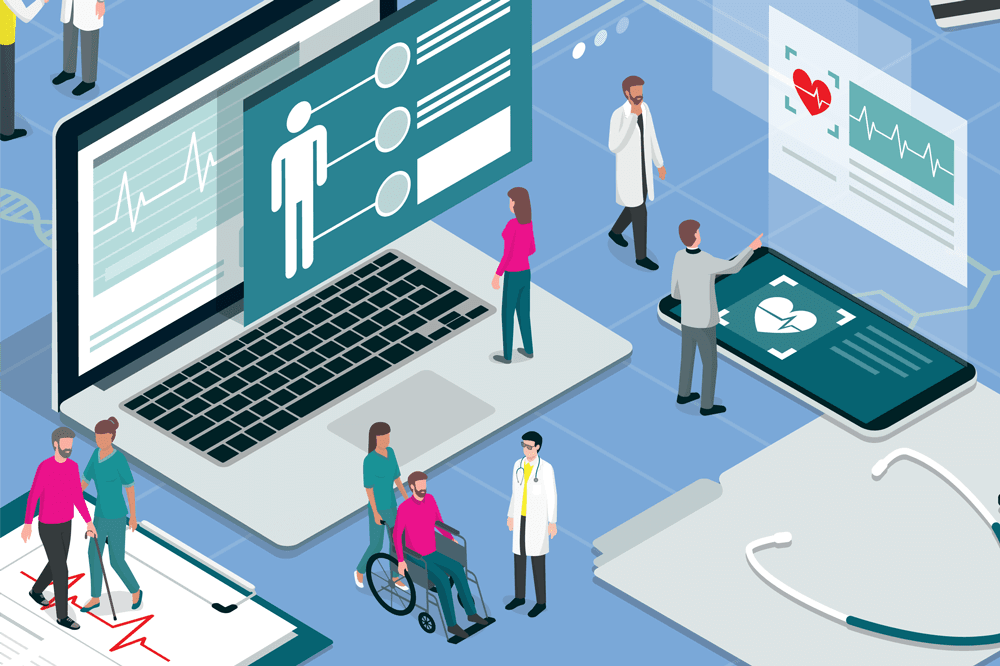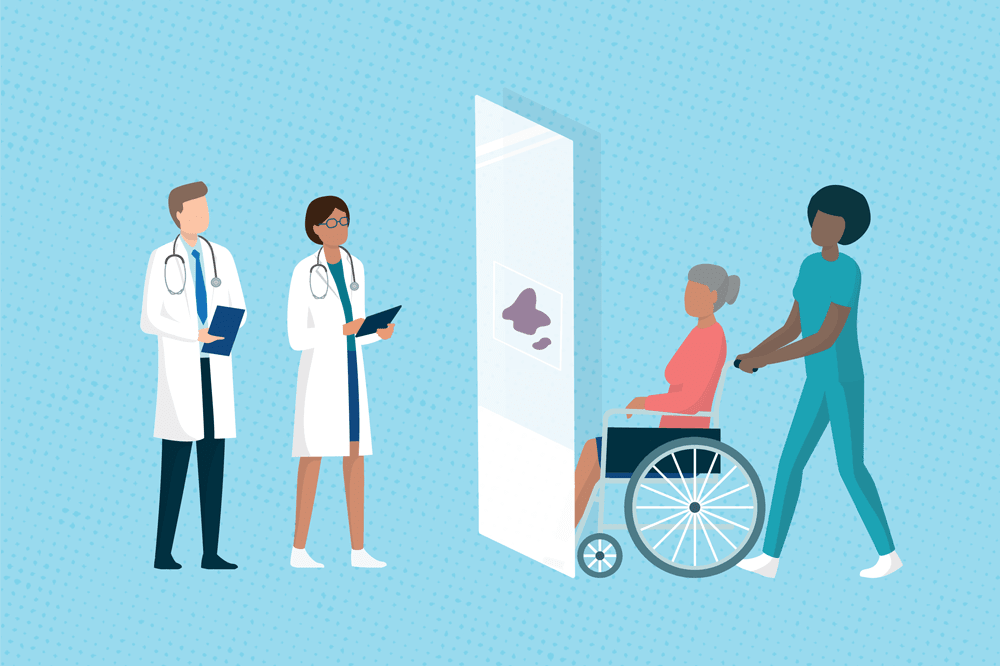As a physician, do you routinely rely on a tissue diagnosis to guide treatment? Do you consistently contemplate whether a deeper level of testing – perhaps molecular, genetic, or cytogenetic – would be a good use of healthcare dollars? Do you know who can help you make this call?
Maybe your specific subspecialty doesn’t always demand it. But let me pose a slightly different question: Does a typical physician, during the course of their career, need to order and interpret a laboratory test to guide therapy? Do they wonder about whether they need a complete blood count (CBC) with differential, the CBC alone, or just the hemoglobin and hematocrit (H&H)? Do they care about proper test utilization? Is this part of their job?

The answer, of course, is yes – this is a routine responsibility.
So then why, after the second year of a typical medical school education, is pathology training an elective experience?
A solid understanding of every aspect of anatomic and clinical pathology is directly relevant to over 90 percent of practicing physicians every single day. We often hear that 70 percent of all healthcare decisions are based on pathology and laboratory medicine – and we certainly know that most, if not all, medical providers in practice invariably work with pathologists via consultation at some point. Nevertheless, when physicians in training are given the option of elective clerkships to further their understanding of our vital specialty, most choose not to engage. It’s clear that these electives aren’t quite hitting the target – so what is the alternative?
A universal pathology clerkship
In a typical allopathic US medical school, third- and fourth-year students traditionally have several required rotations: internal medicine, family/outpatient medicine, surgery, psychiatry, obstetrics/gynecology, and pediatrics. Most graduating physicians will pursue one of these fields, so exploring all six makes sense. The clerkships serve a multitude of functions: exposure to the field (as a possible career choice); exposure to the discipline for knowledge; and, most importantly, exposure of students to other disciplines whom they, as future physicians, will consult.
The emergency medicine doctor consults a general surgeon when an abscess seems too complex to drain at the bedside. The internal medicine doctor consults a psychiatrist when a patient exhibits signs of suicidality or psychosis. These physicians rely on consultants not because they don’t know how to tackle relevant problems on their own, but because they know that a dedicated specialist can do it better. Deferring to expert opinion when necessary means that our patients have the best possible quality of care – and, as a result, the best possible outcomes.
These expert consultations typically work because the consulting doctor has had some experience, however brief, in the consultant’s field. Each can speak the language of the other – a language most likely learned during their medical school clerkships. Conspicuous by its absence from this list of clerkships, though, is our own discipline. All of the aforementioned specialties interact with ours, whether they know it or not. They order laboratory investigations and send material to pathology. They request expensive tests, interpret complex reports, and navigate the world of molecular diagnostics. In spite of this, most don’t speak the language of pathology. They don’t even know its alphabet. They don’t know who pathologists are or where to find them; often, they don’t even know what pathologists do or how we can help their patients. Would a clerkship change this?
What is pathology?
When most physicians think about the field of pathology, they associate it with definitive tissue diagnosis, a discipline to which they were exposed during their preclinical years in medical school. This understanding is accurate, but it is not complete. Medical students are exposed to the basic histopathologic features of common malignancies and disorders – but they do not typically receive any exposure to the journey a fresh tissue sample takes from patient to final diagnosis. They do not know how many steps are involved in the processing of the tissue, nor do they understand why certain cases take longer to sign out than others. They don’t understand the role of a large team of professionals involved in their patient’s care – the medical laboratory scientist, the pathologists’ assistant, and a dozen others. The only “interprofessional” education most people have seen is the interactions between doctors, nurses, and pharmacists.
Although it is not necessary to understand the granular details of all pathology-related processes, it is necessary to be able to understand how and why things can go wrong. It is necessary to understand why a frozen tissue sample may report a less specific diagnosis than a permanent; why cells cannot be fixed for flow cytometry or cytogenetics; why an H&H (rather than a CBC with differential) will suffice when wondering about a patient’s hemoglobin; why some tests need to ordered when the patient is in an outpatient setting; and why molecular testing of a tumor may or may not be helpful for a particular patient. Are these not relevant questions for every physician? Imagine that you, as a patient, go to your doctor and ask one of these questions. Would you have confidence in your physician if you were met with a blank stare? Most doctors learn the importance of these things through trial and error on the job – not as a feature of didactic teaching during medical school. The number of times lab professionals and pathologists are met with long, awkward pauses on the phone (or, worse yet, belligerent arguments that have no scientific basis) seems too numerous to count.
And fewer still of our colleagues seem aware that “the lab” is more than just tissue diagnosis. Laboratory medicine covers a vast range of disciplines – and yet, not only do most medical students never set foot in a clinical laboratory during their entire four-year education, they also never interact with the individuals who are present to be consulted on these issues. When the result of a test does not correlate with the clinical picture, the clinician needs to know whom to contact and how to speak their language. In the same way, when a clinician relies on laboratory testing to find a solution to an uncommon problem, they may not know which tests to order – and, to find out, they need to know with whom they should consult. Most doctors have developed their own algorithms to decide whom they contact, when to do it, and how to go about it – but wouldn’t it be beneficial to know how a poorly filled blood bottle can change microbiologic culture results? Or that high levels of biotin may mask rising troponins in the setting of an acute coronary syndrome?
Putting the “person” in personalized medicine
If my impassioned plea isn’t enough to convince you, let’s turn our attention to personalized medicine. Companies are now offering all sorts of genetic tests directly to patients at home. These are complicated tests with complex bioinformatics implications and data that may have life-altering results. Are non-pathologist physicians comfortable with all the questions that may arise from such testing? Will they be in the future?
At present, in the laboratory, these techniques are mostly relegated to patients with cancer; they are used to determine specific mutations that may help predict prognosis or indicate the likely success of targeted therapies. However, they are quickly propagating beyond oncology into other fields. Examples include the sequencing of drug-metabolizing enzymes, transcriptomics (mRNA expression levels), proteomics (molecular biomarkers that can often predict toxicity), and metabolomics. These are tests that will affect every physician’s patients.
Let me offer an example. A recent addition to our precision arsenal is vitamin K epoxide reductase complex (VKORC1) and cytochrome P450 2C9 (CYP2C9) function testing. VKORC1 is a protein that regulates vitamin K levels in the body; CYP2C9 is an enzyme that metabolizes the blood thinning drug warfarin. If a patient has a molecular test in their chart that shows poor VKORC1 function and homozygous CYP2C9 alleles, it is the responsibility of any physician who prescribes warfarin to know that the patient is at high risk of bleeding if started on the drug at normal titrating doses. Alternatively, assume a pathologist conducts a genetic test on a solid tumor and discovers a germline mutation of significance. Presumably, every physician who comes into contact with this patient needs to know what to do with this information, because the patient’s problem is not a single cancerous tumor; it is, presumably, a lifelong genetic condition.
Adding a new checkbox
In our experience, the lack of a clerkship also underlies most misunderstandings that non-pathologists have about a career in our field. Most pathologists have heard the concerned cry of, “But you’re such a people person!” from colleagues who are worried that their choice of specialty may not be well-suited to a happy, outgoing personality. Most of these comments come from doctors who rarely set foot in the lab – and a clerkship could change this negative perception of our discipline. Medical students mentally check the boxes of possible career options after their clerkships end. “Yes or no: do I want to stay in this field for the rest of my life?” They run through the options. “Psychiatry: no. Internal medicine: no. Surgery: yes.” But there’s one glaring omission; pathology isn’t even on their list! There is no box to check, so they never even give themselves the option of saying yes. And when exclusion is the default option for a field as fundamental as ours, it has a detrimental effect on healthcare as a whole.
When medical students do not receive exposure to pathologists, laboratory professionals, and the processes and tests we use, we risk the prospect of training an entire generation of physicians who may not know how to interpret the testing for which they are ultimately responsible. In fact, this isn’t even a risk; in many ways, it is already our reality.

Logistics
In a perfect world, medical students would receive exposure to every specialty in medicine. Although logistical reasons obviously make that impossible, it should be noted that most medical students have abundant time for elective clerkships in their fourth year. We argue that a short time spent in a combined anatomic and clinical pathology elective would give medical students enough exposure to understand how the processes of tissue diagnosis and laboratory testing generally function. It would make students include the pathology checkbox on their mental list of options, even if they ultimately choose not to pursue it. A clerkship would allow each and every medical student to make an informed decision about pathology as a career.
But how would this be achieved? Hundreds of medical students rotating through the Department of Pathology each year? It would certainly be no walk in the park. The trick to proper implementation may be involving them in patient care just like residents. We envision streamlined and efficient orientations, active involvement in grossing, frozen, signing out, clinical pathology rounds, and quality assurance and improvement projects. However, despite best intentions, this would be difficult to implement as a “usual” medical school clerkship. Even if medical students were assigned non-urgent cases (for instance, no cancers), the sheer volume of medical students per pathology department would render the clerkship a revolving door of students coming in and out. I can already hear the groans of medical school administrators and pathology faculty alike. Without some “out of the box” thinking, a typical four-week, nine-to-five rotation may face logistical issues too great to allow success.
So how do we make this clerkship a reality? One possibility is the implementation of a longitudinal curriculum that runs alongside the third and fourth year of medical school education. If championed correctly, this could be comprised of a series of didactic lectures, microscopy, and laboratory sessions that deal with a set number of students at a time. Students could learn about grossing and histology by seeing the gross room and working with 3D-printed organs. Frozen sections of vegetable matter, cytopathology on animal livers or spleens, and similar hands-on workshops would let medical students expand their pathology horizons without negatively impacting patient care. They could try their hands at processing blood and urine samples, looking for and reporting crystals in body fluids, spiking samples with interfering substances, and more.
A longitudinal program would also introduce the possibility of working with additional members of the healthcare team. Medical laboratory scientists, histotechnologists and everyone else who works in AP and CP labs would offer the valuable interprofessional learning experiences we want for our medical students. Between the didactics and practical labs, the rotation could include social media activities (1) and informal learning to impart pearls of pathology algorithms and information. This way, everyone would see the details they need – and, for those intrigued by their first taste of our discipline, the customary pathology elective would let them delve deeper on a case-by-case basis.
As healthcare changes and we scrutinize our expenditures more and more, we suggest that we might find easier or better solutions to our healthcare problems by including pathologists in the discussion, and by giving non-pathologist physicians a better understanding of microscopic diagnostics. These aren’t theoretical possibilities somewhere in the nebulous future of our healthcare system; these are real, current issues. How medical students view pathology as a career; the way our colleagues perceive pathologists; the degree to which everyone needs to understand the dollars and cents of diagnostics – a trio of reasons as to why medical educators must begin to have conversations about creating a universal, non-optional pathology educational experience. Such an experience could take a number of forms – standalone or longitudinal, third or fourth year – but the time for creating such a clerkship is long overdue.
Kamran Mirza is Assistant Professor of Pathology and Laboratory Medicine and Medical Education at Loyola University Chicago.
Austin McHenry is a medical student at Stritch School of Medicine, Loyola University Chicago, USA.

References
- K Mirza, “#Twitter Homework”, The Pathologist (2018). Available at: https://bit.ly/2Ju5vpd.




